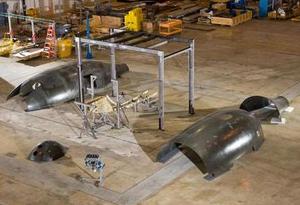Boeing develops Phantom Eye UAV, hopes for bigger share of UAV market
The unmanned aircraft market is currently dominated by Northrop Grumman and General Atomic; Boeing wants to change that, and it is working on the Phantom Eye — a UAV with a 150-foot wingspan which will carry a payload of as much as 450 pounds up to 65,000 feet in altitude; the UAV will be powered by a hydrogen-fueled Ford compact truck engine

The Phantom Eye UAV under construction // Source: avstop.com
Boeing is working to broaden the offerings of its Unmanned Airborne Systems division through development of a surveillance aircraft — powered by a hydrogen-fueled Ford compact truck engine — which will be able to loiter at high altitudes for up to four days.
The Phantom Eye prototype, now being assembled by Boeing Phantom Works in St. Louis in collaboration with the Kent, Washington-based Unmanned Airborne Systems unit, is to fly in early 2011, said Phantom Works spokesman Chris Haddox. “We worked closely with the UAS division,” Haddox said. “The idea with the UAS division and UAV (unmanned aerial vehicle) portfolio is to create this family of UAVs to serve various missions.”
St. Louis Business Journal reports that a key to the aircraft is power from the modified 2.3 liter Ford engine, which is adapted to give the aircraft the greatest possible range for the weight of engine and fuel. The hydrogen fuel will provide three times as much power as gasoline for the same weight of fuel, Haddox said.
The project is internally funded, and is part of an effort by Boeing to catch up in the unmanned aircraft market, currently dominated by Northrop Grumman and General Atomics. Development of the power system is led by Boeing with Mahle Powertrain and Ford as technology partners.
The alliance with Ford has nothing to do with the fact that former Boeing Commercial Airplanes CEO Alan Mulally is now CEO of Ford, Haddox noted. He said work with Ford on use of hydrogen as a fuel had been underway before Mulally left Boeing in 2006.
The demonstrator will have a 150-foot wingspan, and will carry a payload of as much as 450 pounds up to 65,000 feet in altitude. No such aircraft now exists, Haddox said.
Boeing also is developing Phantom Ray, an unmanned fighter that is scheduled to fly in late 2010. “We believe Phantom Eye and Phantom Ray represent two areas where the unmanned aerial vehicle market is heading,” said Dave Koopersmith, Advanced Boeing Military Aircraft vice president.
St. Louis Business Journal notes that Boeing’s Defense, Space & Security unit, led by Chief Executive Dennis Muilenburg, is the second-largest employer in St. Louis with $33.7 billion in revenue in 2009 and 16,000 local workers.